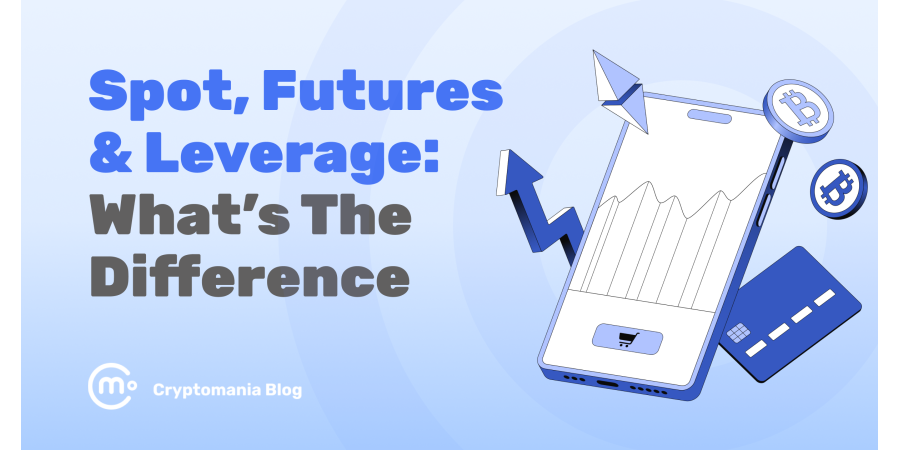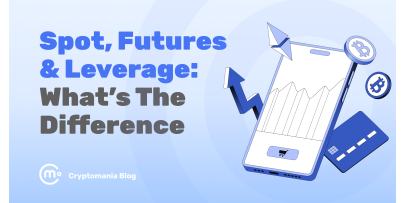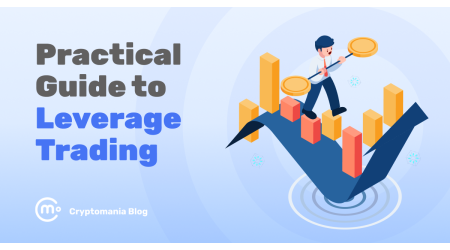Spot, Leverage, and Futures Trading in Crypto: A Comprehensive Guide to Types, Benefits, and Risks
Vuk Martinovic


You’ve heard that crypto trading can be quite profitable for some, but there are different kinds of trading. Spot, leverage, and futures trading offer distinct ways to trade in the crypto market. You’ll want to understand the benefits and risks of each method to make informed decisions.
Spot trading lets you actually own the assets, while leverage trading amplifies your trading position – and potential profits or losses. Futures trading, meanwhile, allows you to speculate and hedge, but you need a deeper market understanding.
As you consider your trading strategy, you’ll need to weigh the advantages and risks of each approach. But which method is right for you, and what are the consequences of choosing wrong? This article will help you answer that question.
Key takeaways
- Spot trading involves buying or selling cryptocurrencies at the current market price. You truly own the asset, and there is usually high liquidity.
- Leverage trading amplifies potential gains and losses through borrowed funds. It requires strong risk management skills and careful market analysis.
- Futures trading allows you to speculate on future crypto prices without owning the assets. It’s good for hedging.
- Direct asset ownership and control over pricing are key advantages of spot trading, while leverage trading offers increased profits and requires less capital.
- You must understand the risks, such as market volatility and liquidity risks, to be successful at any kind of trading, whether it’s spot, leverage, or futures.
Understanding spot trading
In crypto, spot trading is a fundamental concept to understand.
Spot trading involves buying or selling cryptocurrencies at the current market price, with immediate settlement and no delay in the transaction.
Understanding spot trading’s mechanics, benefits, and risks will help you determine if it’s the right strategy for you.
What is spot trading?
Spot trading’s primary function is to enable the immediate buying or selling of cryptocurrencies at the current market price, (also known as the spot price).
When you do spot trading, you’re essentially buying or selling a cryptocurrency at the price the market currently thinks it’s at. Usually it’s done via crypto exchanges like Coinbase or Kraken.
Spot trading is typically easier to understand, compared to leverage or futures trading. This type of trading is settled immediately, meaning the transaction is completed in real time.
Market liquidity plays a vital role in spot trading, as it determines how easy or hard it is to buy or sell a particular cryptocurrency. High market liquidity makes sure that you can execute trades quickly and at fair prices.
Advantages of spot trading
- Spot trading means you directly own the asset, which gives you full control to transfer, use, or store assets as you wish.
- High liquidity in major cryptocurrencies like Bitcoin and Ethereum enables quick trade execution without major price impact.
- You can set your own prices, giving greater control over trade outcomes.
- Spot trading avoids leverage, so there’s less risk of huge losses quickly.
- It’s versatile for both long-term portfolio building and short-term trades, because you can respond to market fluctuations profitably.
Risks of spot trading
- Market volatility can cause rapid price fluctuations, leading to potential losses if positions aren’t carefully managed.
- Liquidity risks with smaller cryptocurrencies may make it challenging to buy or sell quickly.
- Exchange hacks, regulatory shifts, and security breaches pose extra risks that could compromise assets.
Who is spot trading best for?
Investors with a solid grasp of market analysis who don’t want to take on extra risk are ideal candidates for spot trading.
You’re comfortable with the possibility of losing some or all of your investment, but at least not quickly, and you’re able to make decisions based on market trends and analysis.
This includes experienced traders, institutional investors, and sophisticated individuals seeking to capitalize on market fluctuations.
You’re also willing to invest time and effort into monitoring the markets, analyzing data, and adjusting your strategies as needed.
If you fit this profile, spot trading can provide you with a flexible and efficient way to trade cryptocurrencies and have good returns.
Understanding leverage trading
We’re moving on to leverage trading, a type of trading that allows you to control large positions with a relatively small amount of capital.
Leverage trading has certain advantages that can be very powerful, such as increased potential gains. On the flip side, this comes with some inherent risks, such as increased potential losses.
Once you understand the mechanics and implications of leverage trading, it will help you determine whether it’s a suitable strategy for your trading goals and risk tolerance.
What is leverage in crypto trading?
Leverage trading is a powerful tool that can amplify both potential gains and losses.
With leverage trading, you’re essentially borrowing capital from a lender or broker to increase the size of your trades. This allows you to control larger positions with a smaller amount of your own capital.
Leverage mechanisms, such as margin accounts or futures contracts, enable you to tap into this borrowed capital. In cryptocurrency markets, leverage can range from 2x to 100x or more, depending on the exchange and specific trading instrument.
If this seems too technical, let’s take a look at an example.
Let’s say the price of 1 ETH is $3,000, and you buy $100 worth of ETH, and let’s say you’re not using leverage (i.e. leverage is 1x). If ETH’s price goes up from $2,000 to $2,100, that’s a 5% increase. So, your $100 of ETH becomes $105.
Now, let’s assume the same scenario, but with one key difference. Instead of not using leverage, you’re now using leverage of 5x. Suddenly, when ETH’s price goes up from $2,000 to $2,100, your $100 doesn’t become $105. Instead, it becomes $125.
It happened because you used 5x leverage, and all the potential profits (and losses) are multiplied by 5. So, with a 5% increase, and when using leverage of 5x, you actually achieved a 25% profit.
What would happen if ETH’s price decreased? Well, the same, but in reverse. Let’s say ETH’s price drops from $2,000 to $1,800, which is a 10% drop. Now, instead of losing 10%, you lose 50%. As a result, your $100 becomes $50.
If this seems risky, that’s because it is. Leverage trading can be extremely lucrative, but it can also be very harsh if you end up making the wrong decision. The higher the leverage, the more risky your trade is.
Advantages of leverage trading
- Leverage trading allows for amplified gains by using borrowed capital. This increases position size for potentially larger profits.
- It’s especially effective in a bull market since you can maximize returns as prices rise.
- If you include setting stop-losses and adjusting leverage ratios properly, you can reduce the risks.
- With well-planned strategies, leverage trading can significantly boost your returns on market trends.
Risks of leverage trading
- Leverage trading can lead to significant losses, as borrowed funds amplify both gains and potential downturns.
- Regulatory changes may impact market liquidity and volatility, which may complicate leveraged trades.
- Margin calls can require additional deposits or forced asset sales. This adds risk if markets move unfavorably.
- Effective risk management is critical, as losses can be higher than the initial investment without careful planning and market monitoring.
Who is leverage trading best for?
Leverage trading is great for traders with a high-risk tolerance and solid market experience. It suits those who prioritize potential high returns over capital preservation and can actively monitor trades to respond to market shifts.
This strategy is best for investors with good risk management techniques, as they’ll need to handle margin calls and mitigate the potential for amplified losses. It’s also a good choice for traders looking to capitalize on short-term price movements in fast-paced, high-volatility markets.
Another important thing is to have good control over your emotions. Trading crypto is risky by default due to the volatility, but this is increased even further when using leverage. In these situations, you need to be able to keep your cool and make rational decisions, not emotional ones.
Understanding futures trading
Futures trading allows you to speculate on the future price of cryptocurrencies. By trading futures, you can gain exposure to potential price movements without actually owning the underlying assets.
This can be a useful tool for hedging or speculating. In this section, you’ll learn the ins and outs of futures trading, including its advantages and risks, to help you determine if it’s a strategy that’s right for you.
What is future trading in crypto?
Futures trading is a type of financial instrument that allows you to speculate (some would say “bet”) on the future value of cryptocurrencies.
With futures trading, you’re essentially entering into a contract to buy or sell a cryptocurrency at a predetermined price on a specific date.
This can be useful for those who want to profit from price movements in the crypto market without directly holding the asset.
In futures trading, you take one of two primary positions: long or short.
- Going long means you believe the asset’s price will increase by the time the contract expires. If your prediction is correct, you profit from the increase.
- Going short means you expect the asset’s price to decrease. You agree to sell the asset at the contract price, potentially profiting if the price indeed drops.
Once again, let’s take a look at an example.
Imagine you expect the price of ETH to increase from $3,000 to $3,500 over the next month. You enter a futures contract to buy ETH at $3,000. Basically, you “promise” to buy ETH for $3,000.
If ETH’s market price indeed rises to $3,500 by the time the contract expires, you’d profit from the $500 price difference per ETH (minus any fees). However, if ETH’s price drops to $2,500, you’d face a loss of $500 per ETH. Both the profit and loss would be amplified if you’re using leverage.
Why would you do this instead of simply buying ETH directly via spot trading, and then profiting from the price increase? There are two common reasons:
- Some people don’t want to own the asset, in this example ETH. Perhaps they don’t want to deal with using the right chain and all the little details of it. Perhaps it’s for tax purposes. Whatever the reason, they’d prefer to profit from price changes without actually owning the asset.
- If you think ETH’s price will go down, but you don’t own any ETH currently, futures trading is a convenient way to profit if your price prediction turns out to be correct.
Advantages of futures trading
- Futures trading can hedge against losses in a portfolio. It’s a way to reduce overall risk.
- It allows traders to speculate on price movements, creating potential for amplified gains.
- You don’t own the underlying asset, which is exactly what some traders prefer.
- Futures trading makes it easier to respond quickly to fluctuations and adjust positions for maximum profit.
Risks of futures trading
- Futures trading involves market volatility, where sudden price changes can turn profits into significant losses.
- Futures trading can be complex and technical, and it’s not as clear-cut as spot trading.
- Price fluctuations in underlying assets, influenced by market and economic factors, add to risk.
- You don’t own the underlying asset, which, while it can be good, can also be a con. It also typically isn’t good for long-term trading or hodling.
Who is futures trading best for?
For traders seeking to capitalize on market fluctuations and maximize their potential returns, futures trading can be a viable option.
You’ll need a solid understanding of the markets, as well as the ability to analyze market trends and make informed decisions quickly.
Futures trading is best for those with a high-risk tolerance and a significant amount of capital to invest. It’s also great if you don’t actually want to hold any crypto yourself, you just want to profit from the changes in price.
Generally, you should have experience with futures trading, as this will help you deal with the complexities of futures contracts and margin calls.
If you’re new to trading, it’s probably better to start with spot trading or leverage trading before moving to futures.
However, if you’re an experienced trader looking to diversify your portfolio and increase your potential returns, futures trading may be an attractive option.
Spot, leverage, and futures trading comparison
| Factor | Spot Trading | Leverage Trading | Futures Trading |
| Asset ownership | Direct ownership of the cryptocurrency, which can be held or used as desired | No direct ownership, as borrowed funds are used | No ownership, only contracts based on asset price |
| Risk level | Lower risk, as no borrowing or leverage is involved | Higher risk due to amplified losses with borrowed funds | High risk, especially with leveraged contracts and market volatility |
| Potential gains | Gains are limited to asset price increase | Amplified potential gains due to leverage | High potential gains from speculation without holding the asset |
| Capital requirements | Requires full amount for each asset purchased | Requires less initial capital, as leverage increases position size | Low initial capital, leverage is often applied to the contracts |
| Market knowledge needed | Intermediate understanding of markets | Strong market knowledge and risk management needed | Advanced understanding of markets, trends, and futures dynamics |
| Ideal use case | Long-term holding or straightforward buying/selling | Short-term trading with a focus on maximizing gains | Short-term speculation or hedging against price declines |
| Impact of market fluctuations | Price fluctuations directly impact asset value | Amplified effects of market changes on profit and loss | Highly sensitive to price movements, high potential for both gains and losses |
Bottom line
You now (hopefully) have a solid understanding of spot, leverage, and futures trading in the crypto market. Each type offers distinct benefits and risks, and you need to understand what you’re getting into, no matter which type of trading you do.
Recognizing your risk tolerance, market knowledge, and financial goals, you can choose the trading method that suits you best. Of course, you can always choose more than one.
Whatever your choice is, effective risk management is hugely important to deal with the crypto market’s volatility and unlock its potential for growth and returns.





